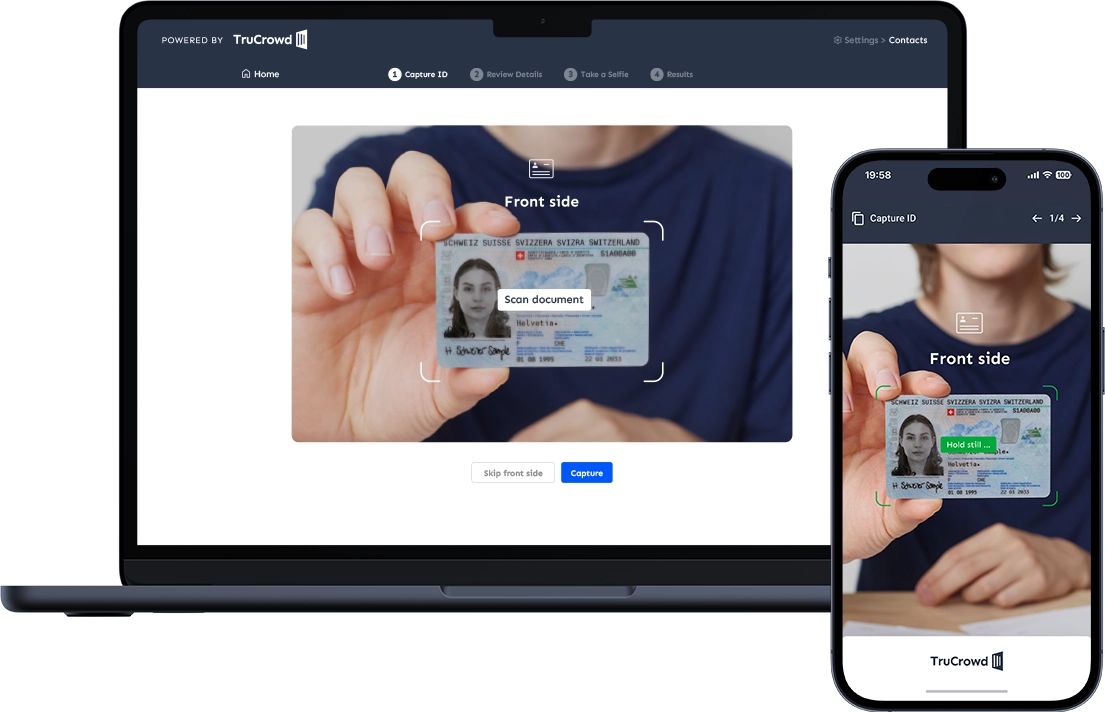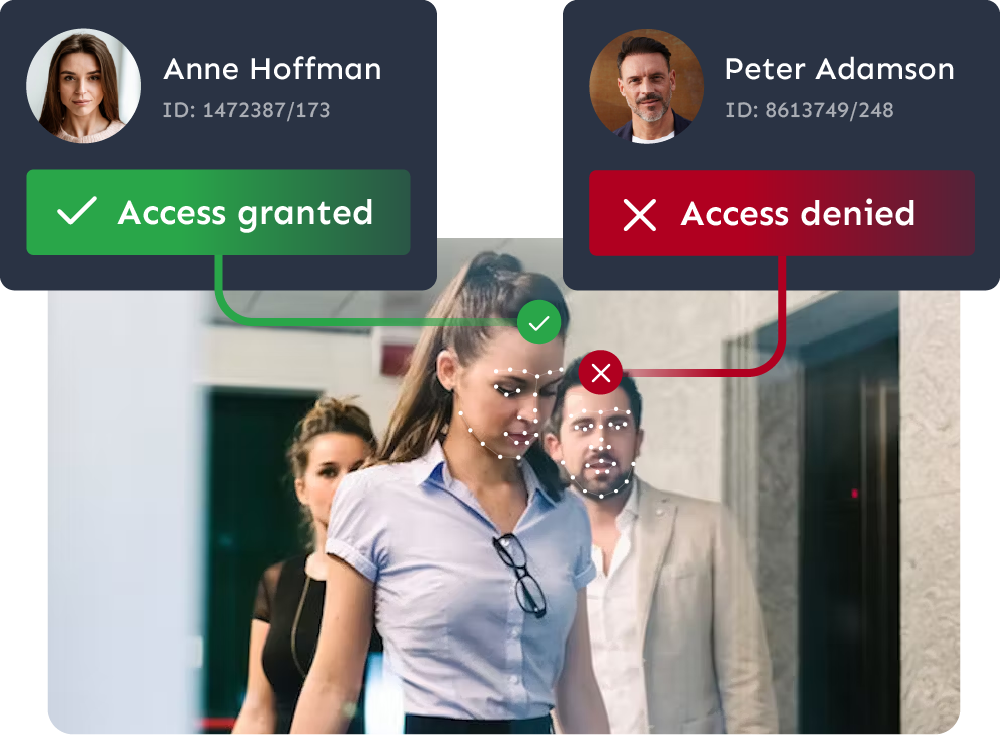Biometric technology trusted by more than a billion users
As a spinoff from biometric technology leader Innovatrics, we bring the most advanced biometrics for fan identity verification available as a service to football clubs and event organizers.
We guarantee always up to date algorithms and proven performance in real life conditions of 600+ large scale projects.
Identity Document Capture and Authenticity Check
In case full fan identity verification (KYC) is necessary to purchase a ticket, fans are prompted to take a photo of their ID, from which textual data is extracted. The ID photo is then matched with a selfie in the second step.
Document Auto-capture
To ensure a seamless experience during the remote fan identity verification process, we provide auto-capture components. These guides assist users in taking the best possible quality photo of their ID for optimal OCR performance and to minimize image rejection.
Document Data Extraction
Our technology recognizes the identity document, extracts all the required fields, and parses them into text. Simultaneously, it retrieves the portrait image and converts it into a secure biometric template for biometric identity verification.
Document Authenticity Verification

Face Registration, 1:1 matching
After capturing the document, fans take a selfie which is checked against the identity document image. If the images match, the fan identity verification algorithm returns a positive result.
Face Auto-capture
To make the face registration seamless for users, our solution provides an auto-capture component. It requires fans to center their face in the requested area of their device.
Face Verification
Once the user’s selfie is captured, it is converted into a biometric template. Face recognition algorithm then compares a holder’s photo on the ID with a selfie to biometrically verify that the ID belongs to the same person.
Passive Liveness Detection
Facial liveness detection verifies if a user is physically present at the time of the remote fan identity verification process to prevent identity fraud. It detects people presenting a mobile picture, printed picture, any kind of 3D mask, or injection attack.

Identity-based access control, 1:N matching
Innovatrics algorithms deliver superior facial recognition for venue access. This ensures only authorized users enter, while maintaining smooth traffic flow at high volumes.
Flexible Face Access Rules
Fine-tune your access strategy. Restrict facial recognition zones to specific areas around access points, set alerts for banned individuals, or enable faster multi-person matching for seamless gate access.
Top-Ranked Biometric Algorithms as a Service
Our algorithms consistently score top marks on the Face Recognition Vendor Test (FRVT) organized by the US-based National Institute of Standards and Technology (NIST), the most trusted benchmark for biometric technology.
Seamless Cloud Integration
The Facial Identification Service identifies faces captured by cameras and matches them against cloud-based watchlists. Positive identification allows access control at gates, parking lots, or payment terminals.
Low Bandwidth & Scalability
Our embedded algorithms can efficiently run time-critical operations such as face detection, facial landmarks, and face template extraction through on-edge or on-chip processing.
Our edge-based processing minimizes network bandwidth requirements. This allows easy system scaling to virtually unlimited cameras, ensuring fast and reliable venue entry.

Benefits
Why should you adopt fan identity verification
Face biometrics is revolutionizing the event industry. Governments increasingly require institutions to verify visitors, ensuring only authorized access. We believe face-based entry is the future. Implementing it now allows you to deliver an exceptional gameday experience to your fans.
By tying tickets to identity, all transfers and resales can occur exclusively under your control.
Preventing hooligans from entering stadiums, make the events safer and more family-friendly.
By verifying legal identity during purchase, fans can enjoy faster access and a smoother stadium experience.
Personalized Fan Experience
By connecting every purchase to specific individuals, we enable individually crafted fan experiences.
Secure & Quick Payments
By securely verifying your fans’ identities, other services such as face payments become instantly available.
- How accurate is TruCrowd’s facial biometrics algorithm?
- What is Digital Onboarding?
- How do you deal with non-standard or foreign identity documents?
- What is Biometric Liveness Detection?
- What if a buyer uses someone else's identity document during fan identity verification?
- What if an individual tries to onboard with an expired identity document?
- What if an individual tries to onboard with a fake identity document?
- What happens with my face capture during face registration?
- What happens with my face capture when I’m accessing the event with a face ticket?
- Is the Face Access Technology compatible with existing venue management systems and turnstiles?
- How easy is it to integrate TruCrowd with my current ticketing system?
- What's the difference between Face Verification vs Face Identification
- Can I trust the performance and quality of TruCrowd’s biometric technology?
FAQs about fan identity verification technology
We bring you a deeper look into the biometric technology behind fan identity verification and how it works.
How accurate is TruCrowd’s facial biometrics algorithm?
TruCrowd leverages Innovatrics biometric technology, which ranks among the best globally. Biometric verification used during face onboarding has a success rate of 99.66%.
Biometric identification during venue entry has a success rate of 99.89% with a database size of 1,600,000. However, TruCrowd creates a smaller watchlist for each event, including only ticket holders, which decreases the database size and increases matching speed and accuracy.
The search time is 500ms/core. Thus, with standard multi-core devices the search easily happens below 250ms required by most high-level venues.
For more details, you can visit the website of the National Institute of Standards and Technology (NIST), the only trusted global benchmark for biometric technologies. Be cautious of technologies not listed, as they may not perform well in large crowds or be susceptible to fraudulent attempts.
What is Digital Onboarding?
Digital onboarding is the process by which new users initiate their use of a service or open an account online. While this process may be straightforward for certain services, such as online shopping, it becomes more complex for industries like banking that require identity verification to comply with regulations. In such cases, the digital onboarding process encompasses online identity verification.
This entails confirming that the individual’s identity aligns with the information provided in their documents, a task that historically necessitated in-person checks. However, advancements in technology, particularly in face biometrics, now enable users to securely verify their identity online by scanning a government-issued ID and their face. This method offers convenience without compromising security.
This digital process mirrors the traditional method employed by authorities in person. For instance, a police officer or clerk would compare the photo on your ID with your physical appearance to confirm your identity. Biometric facial recognition algorithms replicate this process, but with greater accuracy and speed. The computer analyzes the photo on your ID and compares it to a selfie you provide, a procedure technically referred to as 1:1 verification, where one photo from your ID is matched against one from your selfie. This innovative approach grants access to various services that were previously restricted to in-person interactions, all from the comfort of your home or while on the move.
How do you deal with non-standard or foreign identity documents?
TruCrowd system is equipped to handle up to 1000 types of identification documents, utilizing advanced algorithms to verify non-standard and foreign IDs efficiently.
We consider an identity document acceptable for face ticket registration if it is an official document that proves a person’s identity. This is done by providing the person’s face and their name and other details that uniquely identify them.
Data needed to uniquely identify a person:
- Face photo
- Name (full name whether in one field or split into multiple fields)
- Date of birth
- Additional identifiers needed, like personal number, parent’s names, etc.
Data needed for a unique ID document:
- Document unique number
- Date of document expiry (There are existing documents that do not expire, but this practice is now avoided by governments, as the photos need to be updated on the documents regularly to cope with a person’s aging. Old documents without expiration can be supported but may have downsides.)
TruCrowd supports identity documents of the following types:
- Passports
- Identity cards
- Driving licenses
- Foreign permanent residence cards
- and other cards of similar format containing a photo of the holder
The support for document recognition may be in two levels:
- Level 1 means extraction of the data found in the MRZ zone.
- Level 2 means extraction of all the data in both the visual inspection zone (VIZ) and MRZ zone (if present).
For Level 2 support, the DOT Document Server needs to be trained to support each individual document type and its edition.
Please check the availability of the required document in the list of supported documents for both levels.
In the case an ID document type required for your project is not mentioned in the list, a future version of the Document Server can be trained to support it. Please contact TruCrowd to request it.
Documents not containing an MRZ field and not supported by Level 2 are classified as unknown documents.
What is Biometric Liveness Detection?
Liveness detection is a vital process that ensures the person validating the face ticket online during digital onboarding is indeed the individual they claim to be. By verifying that the selfie is captured from the person purchasing the ticket and not a simulated representation (such as a photo, video, or mask), liveness detection enhances security and authenticity.
Powered by AI, liveness detection algorithms distinguish between genuine interactions by live human beings using real faces and fraudulent attempts, such as spoof attacks or presentation attacks.
This method securely determines whether a biometric sample, like a selfie, originates from a legitimate human source or from a deceptive representation, such as a photo, video, or mask.
With the capability to discern live individuals from presentation attacks, which may involve masks, photos, or videos, liveness detection plays a crucial role in identity verification processes across various sectors, including banking, telecommunications, eGovernment, and the sharing economy.
TruCrowd’s solution employs liveness detection by Innovatrics. The effectiveness of various liveness algorithms can be assessed through tests conducted by the National Institute of Standards and Technology (NIST). The latest NIST FATE PAD report details the evaluation results of 82 algorithms from 45 developers tested for two specific use cases: impersonation and evasion.
What if a buyer uses someone else's identity document during fan identity verification?
The fan identity verification algorithm will not find a sufficient match if the face image on the document does not align with the selfie. If a buyer attempts to alter the selfie with a deepfake or uses printed or digital photos, our advanced liveness detection will identify the attempt and block the fan identity verification process. This ensures that the person taking the selfie is genuine and prevents fraud.
What if an individual tries to onboard with an expired identity document?
TruCrowd technology will detect the expired document and deny further progress in the fan identity verification process, requiring the individual to present a valid document.
What if an individual tries to onboard with a fake identity document?
TruCrowd can detect fraudulent attempts by analyzing various elements of the document, including the MRZ zone, NFC chip, fonts, and field placement. The system can also identify if the original face image has been obscured by an alternative.
What happens with my face capture during face ticket registration?
During face registration, such as when purchasing a ticket or joining a club, we utilize a process known as face verification.
Face verification is initiated by the user and requires consent, similar to confirming identity for a bank account opening using one’s device. It involves verifying the individual’s presence and comparing their facial features to the captured ID.
The data may be stored, as is the case with face-based access, or never retained, as in a basic eKYC process. TruCrowd’s solution conforms to privacy regulations such as GDPR.
What happens with my face capture when I’m accessing the event with a face ticket?
To facilitate entry to games or concerts using facial recognition, we require the storage of a biometric template of your face. When you approach the face ticket gate at the stadium, the camera identifies your face from the image, extracts your biometric template, and compares it to the watchlist of approved faces eligible to enter the specific game through that gate.
The technology utilized here is known as biometric identification, specifically 1:N comparison, where the biometric template extracted from the camera at the gate is compared with the N face templates stored in the database.
Is the Face Access Technology compatible with existing venue management systems and turnstiles?
Yes, TruCrowd Face Ticket Technology is designed for compatibility with existing venue management systems and turnstiles.
It offers flexible implementation, either by integrating with your current gates equipped with cameras or through our advanced electronic gates, enhancing access control through seamless communication with our Identity Engine via REST API.
How easy is it to integrate TruCrowd with my current ticketing system?
Integrating TruCrowd with your existing ticketing system is straightforward, thanks to our Digital Onboarding Toolkit’s user-friendly APIs. These APIs are well-documented and designed for seamless integration into web, Android, and iOS platforms. This allows for easy incorporation of selfie and ID capture features into your ticketing sales website or application, facilitating efficient remote identity verification.
What's the difference between Face Verification vs Face Identification?
Face recognition and face verification differ in their application and user interaction. In the case of a face ticket, face verification occurs during the onboarding process. It’s used to confirm your identity against an official government-issued ID. This process mirrors the traditional method used by authorities in person. For example, a police officer or clerk compares the photo on your ID with your physical appearance to verify your identity. Biometric facial recognition algorithms perform the same action, but more accurately and quickly. The computer analyzes the photo on your ID and compares it to a selfie you provide. This is technically known as 1:1 verification, where one photo from your ID is matched against one photo from your selfie. This clever method allows access to various services that were previously restricted to in-person interactions, all from the comfort of your home or while on the go.
On the other hand, face identification involves comparing your face against many others in a database, similar to how a person searches for someone in a crowd. This operation is technically referred to as 1:N identification, where one face from the camera capture is compared against numerous faces in the database. Face identification is used at stadium gates when entering with a face ticket. The access control system contains a watchlist of faces permitted to enter the venue because their face is associated with a ticket. Since this operation requires significant computing power, actual photos of faces aren’t compared. Instead, smart algorithms translate facial features into a unique string of characters called a biometric template—a hash or code specific to each face. During the face scan at the gate, your biometric template is extracted and verified against the list of templates in the database.
Can I trust the performance and quality of TruCrowd’s biometric technology?
Absolutely! TruCrowd uses cutting-edge biometric technology with algorithms that rank in the top 10 positions in the National Institute of Standards and Technology (NIST) benchmark. Additionally, our algorithms are enhanced with liveness detection technology that is certified by iBeta2 and iBeta3, ensuring that only real, live faces are recognized and preventing spoofing attempts.



